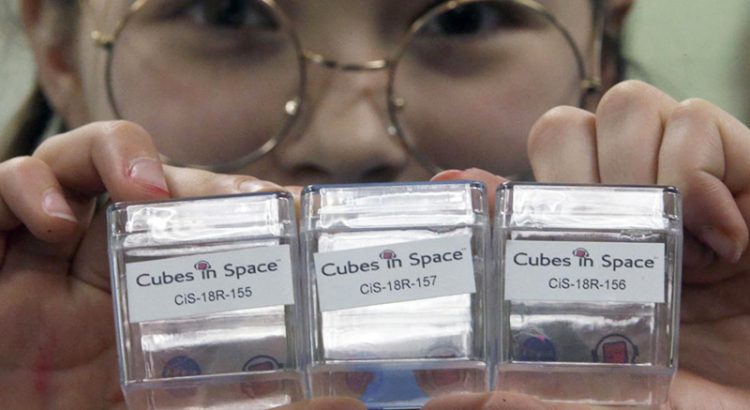How can real science and research be conducted in something that fits in the palm of your hand? Â It takes imagination, creativity, critical thinking and non-traditional problem solving skills to design an experiment that is connected to a real-world Earth or space-based problem and fit into a 4cm X 4cm X 4cm plastic cube. Â As part of the Cubes in Space program, that’s exactly what students do!
Cubes in SpaceTM, a program by idoodledu inc., is the only global competition, offered at no cost, for students 11-18 years of age to design and propose experiments to launch into space or a near space environment on a NASA sounding rocket and zero-pressure scientific balloon. The integrative STEAM-based program is in collaboration with NASA Goddard Space Flight Center’s Wallops Flight Facility, NASA Langley Research Center and the Colorado Space Grant Consortium. Â Cubes in Space brings to young explorers opportunities to discover answers to their own questions. And what better way to give young imaginations and their boundless curiosity a place to soar than the chance to launch a design of their own into space?
Unlike other engineering design challenges, the Cubes in Space program does not provide the students with the problem to solve. Â Instead, students begin their learning journey when presented with this statement, “You will design an experiment to fly to space or near space on a real NASA mission. Â Now what questions do you have?” Â Â At first most students stare at their teachers blankly while crickets chirp in the background. Â Awkward silence hangs in the room like a dense fog until one student is brave enough to ask the question, “How will the experiments get into space?” Another student asks, “How long will the experiments be in space?” Â Now the questions flow freely, and the students are driving the inquiry process. Â This begins their research process.
The Cubes in Space program offers two different airborne platforms on which to conduct experiments and testing.  The Terrier Improved-Orion sounding rocket launches from NASA Wallops Flight Facility on Wallops Island, Virginia in June of each year and carries 80 experiments.  Up to 110 experiments are launched on a 40 million cubic foot zero-pressure balloon from NASA’s Columbia Scientific Balloon Facility in Ft. Sumner, New Mexico in late summer each year.  Students learn about the harsh and sometimes violent launch and environmental conditions of each type of mission.  When the sounding rocket launches, it experiences 20 g’s of downward force with rapid spinning of nearly 60 revolutions per minute when it re-enters the Earth’s atmosphere. Experiments in the balloon can experience temperatures of -65°C, heavy bombardment of radiation, and atmospheric pressure that is 1/100th that at sea level for up to 15 hours at the highest altitude.  These conditions drive the design of the students’ experiments and the types of Earth or space-based problem to which their research could contribute.
What makes Cubes in Space accessible to all students is that they can use easily obtainable and affordable materials found around the house or the classroom to design experiments.  A student could send up something as simple as a marshmallow on the balloon mission if they were going to design a simple way inside the cube to sense the amount of expansion and contraction due to the changes in temperature and atmospheric pressure.  Students can also design more complex experiments such as flight testing hardware to determine if a  nano-computer designed with small circuit boards could withstand the violent forces of the sounding rocket flight.
The requirements and constraints provided by NASA and the size of the plastic cube also help to drive the design of the experiments. Â No liquids, live macroinvertebrates, combustible materials, certain chemicals, or contents pressurized more than 30 PSI can be launched on either airborne platform. Â And with the sounding rocket mission, there is a total experiment mass of 64 grams +/- 2 grams required. Â Even if the experiment plus the plastic cube has a mass of 50 grams, the students must design a way increase the total mass to 64 grams in such a way not to crush the contents.
Students have designed some truly ingenious experiments that have yielded intriguing results and research. Â One group of students from Texas wanted to determine if the element gallium could be used as a radiation shielding material. Â So they coated a brazil nut, which absorbs and traps radiation easily, with gallium. Â They had control brazil nuts of equal size and mass in the lab and in the cube without the gallium coating. Â The students are in the process of analyzing their results. But if the students support their hypothesis that gallium would protect the nut from absorbing radiation, it would be the foundation for further research for gallium as a radiation shielding substance in which aviation and aerospace companies, along with NASA, might be interested.
In early March, students write a proposal and design scientific diagrams for their experiment. Â The proposal and diagram compose the Application for Spaceflight for which educators submit into an online system on behalf of the students. Â It takes a full month for the Review Committee to conduct a preliminary review, provide feedback, and accept the resubmitted proposal for final review.
The process for students to participate is simple. Â Students must have a formal, informal or homeschool educator facilitate the program. Â Classroom educators, club sponsors or even grandparents can register online and find all the content materials and resources to guide students through the learning, research and proposal writing process. Â The deadline for registration is February 2, 2019.
Have students that would love to launch an experiment into space? Visit www.cubesinspace.com to learn more and register! Â Or contact us a info@cubesinspace.com



